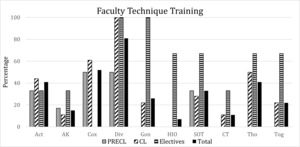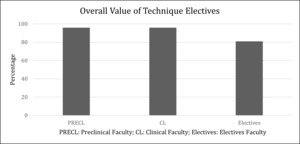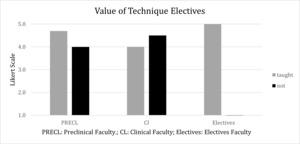INTRODUCTION
The development of our current chiropractic educational standards was established by the creation of the Council on Chiropractic Education (CCE) and its recognition by the United States Department of Education in 1975. These CCE standards created the foundations for the accreditation of colleges and required components of the curriculum, including chiropractic technique education. When the essential elements of highly effective pedagogies, robust technique curriculum, and skilled faculty members are combined, the chances of producing successful practitioners are increased.
Our institution requires each student to complete 435 hours of elective courses between trimester 3 and graduation in a 10-trimester Doctor of Chiropractic (DC) curriculum. These elective courses include various topics within the fields of chiropractic technique, business, massage, soft tissue techniques, sports medicine, yoga, and acupuncture theory. This requirement represents about 10% of the total curriculum. A previous study found that our students took an average of 5 different chiropractic technique elective courses during their chiropractic education.1 The core chiropractic technique curriculum includes 585 hours of preclinical training in Diversified technique. The clinical clerkship training in trimesters 7-10 reinforce the chiropractic technique skills under the supervision of a University Clinician.
Our curriculum’s prescribed course hours, including those in chiropractic technique, were developed by our Integrated Curriculum Steering Committee during a curriculum revision process. This internal campus committee was comprised of select faculty and administrators. Faculty involvement is an important component in the development and implementation of a professional program curriculum.2
The creation of the elective technique course options was driven by student interest in various chiropractic techniques from outside seminars and techniques not previously provided in our curriculum. A new department was formed at our University to oversee the new elective courses. Faculty who teach the chiropractic technique elective courses are required to be certified in the respective techniques taught. Courses are taught using the same format and learning materials as in seminars approved by their respective parent organizations. Based on feedback and interest from our student body, we have implemented and included technique and practice systems that would only be available to our students through technique elective courses. In addition, the National Board of Chiropractic Examiners has surveyed doctors of chiropractic 3 times within the past 20 years regarding their practice methods and preferences, including choice of chiropractic technique. The most recent of these survey results, published in 2005, indicates that diversified is the most commonly used technique, followed by Activator, Thompson, Gonstead, Cox flexion-distraction, SOT, and AK.3 The Activator, Thompson, Gonstead, Cox flexion-distraction, and SOT techniques were all added as electives. (See Table 1)
Past research demonstrated correlations between chiropractic students’ preclinical education (including technique) and the procedures used during clinical clerkship, and in practice.1,3–8 These studies indicate a positive correlation between students’ technique education and technique preference in practice. We were not able to identify any literature regarding the influence of collegiate chiropractic curriculum changes or the impact of technique elective courses on chiropractic technique education from a faculty perspective.
The objective of this study was to quantify faculty perceptions of the technique curriculum revisions, including the addition of the chiropractic technique elective courses, using an anonymous survey, and to provide additional data to drive evidence-guided curricular change in the future.
Our hypothesis was that chiropractic technique faculty valued the Diversified technique courses taught in the core curriculum in trimesters 1-6, and in the clinical clerkship in trimesters 7-10, over the other chiropractic techniques taught in elective courses in trimesters 3-10.
METHODS
We conducted an Institutional Review Board (IRB) approved survey of faculty who teach the chiropractic technique curriculum (preclinical technique courses, clinical clerkship program, and technique elective courses) at our chiropractic college. This survey was anonymous and voluntary. All chiropractic technique faculty were asked to complete an online survey administered through Survey Monkey. A 5-point Likert scale, assigning values from 5 points for strongly agree to 1 point for strongly disagree, was used to record responses. The administration of the survey was supervised by the primary investigator of this project, and the instructions and survey link were provided via email. Sample size was determined by the number of chiropractic technique faculty instructing at the time of administration of the survey. Questions included the faculty’s training in various chiropractic techniques, their faculty department affiliation (preclinical, clinical, or elective faculty) in the technique curriculum, and their perception of the value of all technique components including preclinical courses, clinical courses, and elective courses. Faculty training is defined as completion of a CCE accredited chiropractic institution based course, or completion of an approved chiropractic technique seminar with certification. The survey was pretested for face validity before its administration through a review process conducted by the Dean of the Office of Institutional Effectiveness and 2 chiropractic faculty not included in the survey administration. After peer review, slight modifications were made to the survey instrument based on the feedback. All data were analyzed using SPSS for Windows version 24 (IBM Corp., Armonk, NY) using descriptive and inferential statistics.
RESULTS
Our survey was distributed to 32 technique teaching faculty in 3 departments. Twenty-seven of the faculty responded, for a response rate of 84% (calculated margin of error of plus or minus 5.55%). Twenty-two percent of survey respondents identified as preclinical technique faculty (PRECL), 67% as clinical faculty (CL), and 11% as elective faculty. Survey results indicated that 23 (85%) faculty members were trained in more than 1 technique. A majority of respondents indicated having been trained in Diversified technique (81%) and Cox technique (52%). (Figure 1)
A majority of faculty also valued (strongly agree and agree on the Likert Scale) the role of the preclinical technique courses (96%) and clinical clerkship experience (96%) above that of the technique elective courses (81%) in preparing students for future practice. (Figure 2)
Among survey respondents, 10 of the faculty taught at least 1 elective course. Three were from the preclinical department, 4 were from the clinical department, and 3 from the electives department. Of the 17 respondents who taught none of the elective courses, 3 were from the preclinical department, and 14 were identified as being from the clinical department.
In assessing the value of the technique electives education, the preclinical faculty who taught elective courses placed a higher value on those courses than faculty who did not teach elective courses from the same department, whereas the clinical department faculty who taught elective courses valued them less than faculty who did not teach elective courses from their department. All elective course faculty members who taught technique elective courses placed the highest value on the elective courses. (Figure 3)
Regardless of faculty department affiliation (preclinical faculty, clinical faculty, and electives faculty) all faculty respondents perceived value (strongly agree and agree on the Likert Scale) in the preclinical, clinical, and elective technique education in preparing students to perform effective chiropractic procedures in their future practice. (Figure 4)
The survey data also indicated that 85% of participants valued (strongly agree and agree on the Likert Scale) the role of elective technique courses for students’ future practice. The respondents’ perception of value of individual elective courses is shown below in Figure 5. Most respondents agreed that the following elective courses would be valuable for students’ future practice: Diversified (93%), Cox (89%), Thompson (74%), SOT (54%) and Activator (52%).
DISCUSSION
Several published studies have identified correlations between chiropractic students’ preclinical technique education and the procedures they use during clinical clerkship training, and while in practice.1,3–8 These studies indicate the perceived value of chiropractic technique education from the perspective of students, and graduates, but not of chiropractic technique faculty.
Leone4 surveyed graduates of 2 chiropractic colleges about their use of different treatment procedures. A positive statistically significant correlation was found between the use of Activator, Thompson, Gonstead, and Cox flexion-distraction techniques and the number of hours of instruction in these procedures at the respective colleges.
Mykietiuk et al.5 surveyed graduates of Canadian Memorial Chiropractic College (CMCC) who had been solely instructed in the diversified technique to determine the technique systems being used in practice. They found that 86% of their respondents primarily practice diversified technique. The study reported that the only other technique practiced by more than 50% of the respondents was Activator Methods.
Vermet et al.6 surveyed supervising clinical faculty at CMCC to assess the integration between chiropractic students’ preclinical education in diagnostic and therapeutic procedures and their use of these procedures. The study concluded there was considerable integration between the teaching and practice of the spinal adjustive techniques.
Gleberzon and Stuber7 surveyed practicing chiropractors in Canada in their use of diagnostic and therapeutic procedures. The study found that the most common adjustive procedures utilized were Diversified (91%) and Activator (75%). The majority of the respondents in this study were graduates from CMCC where diversified was the primary technique taught.
A previous survey of students at our institution found that the chiropractic technique curriculum had the greatest influence on students’ choice of technique in future practice.8 The students surveyed agreed that the chiropractic technique curriculum and their experiences with chiropractic practitioners were the 2 greatest bases for their technique preference in practice. This result indicated the students appeared to have the same practice technique preferences as practicing chiropractors as reported in the NBCE Job Analysis Survey of 2005.3
Another previous student study at our institution evaluated perception of the value of individual technique elective courses and the likelihood of using of a specific technique in practice.1 More than half of the students reported having taken at least 1 elective course in Diversified technique, Cox technique, Activator Methods, or Sacro-Occipital Technique. Additionally, a majority of the students stated they were more likely to use Activator, Thompson, Diversified, or Cox techniques in their future practice after taking an elective course in that technique.
Although the previous studies addressed student and graduate perceptions, we were unable to identify any published studies looking at the faculty’s perceived value of technique education in a chiropractic curriculum. Faculty perception is important because it has a direct impact on the delivery of the curriculum. Similar to the student and graduate perceptions, faculty also perceived value in chiropractic technique curriculum in preparing the students for future practice. Our current study of faculty also indicates that regardless of faculty department affiliation (preclinical, clinical, or electives), whether they taught or did not teach an elective course, or whether they were trained in an elective technique, they value the clinical, preclinical, and elective technique curriculum in preparing students for future practice. This result is similar to student attitudes toward the technique education at our institution as noted in Sikorski et al.8 and Wanlass et al.1
Effective curricular development requires input from faculty, students, graduates, and administrative stakeholders. The data from the current study will help drive evidence-based curriculum revision and development.
Limitations
There are limitations to our study. Due to small sample size in each faculty department affiliation group, we were not able to determine the statistical significance value between the groups. An additional limitation is that this survey was an opinion-based survey, and all faculty may not have understood the questions in the same way. This study was conducted within a single institution. Results may not be generalized to other chiropractic colleges.
CONCLUSION
Preclinical, clinical, and elective faculty perceived that elective chiropractic technique courses were valuable in students’ technique education in preparing them for future practice. Future studies should be done among multiple chiropractic institutions to have better understanding of faculty’s perception about students’ technique education in preparing them for successful practice. These future faculty studies should be compared to similar studies from the student, graduate, and administrative perspectives.
FUNDING
This work was funded internally.
CONFLICTS OF INTEREST
The authors have no conflicts of interest to declare relevant to this work.









